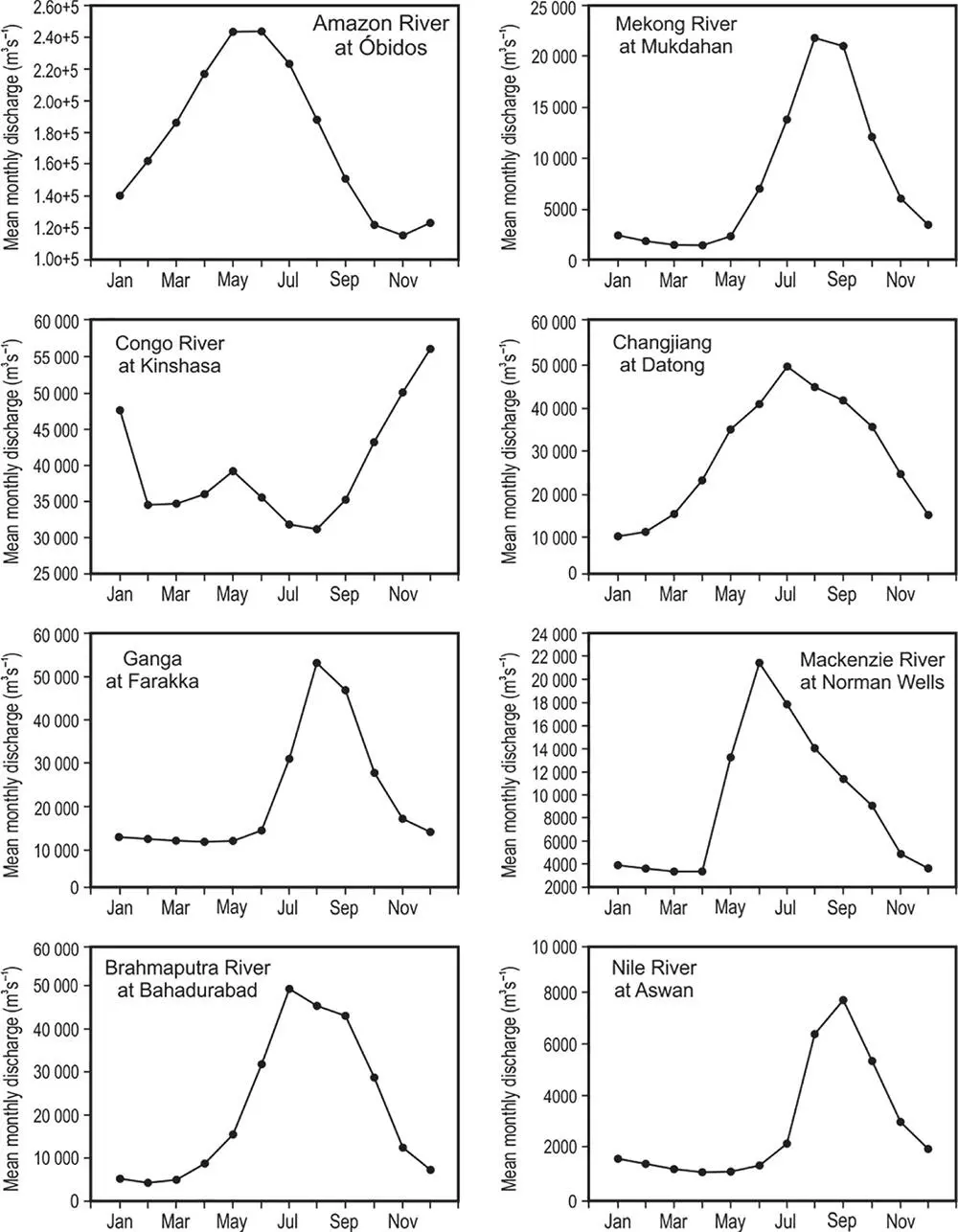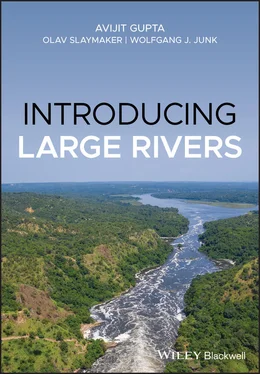1 ...7 8 9 11 12 13 ...21 Flooding may also occur from melting of snow and ice, accumulated earlier, from a number of storms in the winter season. Flooding in the middle latitudes therefore often happens in spring or early summer. A second source of river discharge therefore is the accumulated snow and ice on the land surface of river basins which melts into annual floods as the climate turns warmer.
We can therefore have two classes: a low-latitude barotropic and a higher-latitude baroclinic section. This pattern controls the rise and fall of the river hydrographs and floods. Large floods in big rivers occur under specific circumstances. For example, in the tropics, cyclonic circulations give rise to large rain-bearing storms which may develop up to the strength of tropical cyclones. Heavy, intensive, and episodic rainfall from such storms commonly arrives in the middle of the wet season when the river is high and the ground is wet, giving rise to flood discharges, extensive erosion, and sediment transfer (Gabet et al. 2004). In higher latitudes, floods arrive from a series of large-scale frontal storms, often as rain on snow. Rain-bearing tropical cyclones moving towards higher latitudes, may also contribute to floods in major rivers.
Precipitation may vary considerably from year to year (Amarasekera et al. 1997). The basin of a large river may go through a spell of wet or dry years due to various types of climatic shifts such as the short-term El Niño Southern Oscillation (ENSO) or other climate drivers which operate over longer periods. A full ENSO cycle usually runs for five to eight years. It includes particularly dry years (known as El Niño), and wet years (La Niña). The resulting wet or dry climate is found over various parts of the world at the same time explaining variable flows in large river basins. For example, precipitation and river runoff rise during La Niňa for the Magdalena, Orinoco, and the northern tributaries of the Amazon across northern South America.
The Pacific Decadal Oscillation (PDO) is similar but lasts for 20–40 years. Rivers of the tropics and subtropics are commonly affected by the short-term ENSO and PDO climate drivers. The North Atlantic Oscillation (NAO) affects rivers flowing to the Atlantic and Arctic Oceans. Its influence on precipitation and runoff can be recognised in the runoff pattern of the northeastern and mid-Atlantic rivers of the United States but rivers in Europe are difficult to interpret. Other long-term climatic oscillations are the Atlantic Multidecadal Oscillation (AMO) and the Southern Annular Mode (SAM). Given that a long series of discharge data is available only for a few rivers, the effects of long-term climate drivers on rivers are difficult to investigate.
Runoff of a large river thus reflects various climatic criteria: annual rainfall, seasonality in rainfall, and episodic rain from synoptic disturbances. Not only are the large rivers thus maintained, but their behaviour is also characterised by the run of changing wet and dry years determined by climate drivers, and episodic storm rainfalls. A high average rainfall or floods of limited recurrence interval is required to maintain the channel of a large river.
3.4 Large River Discharge: Annual Pattern and Long-Term Variability
Discharge of large rivers is derived from (i) the nature of precipitation falling on their basins, (ii) melting of ice and snow in spring and early summer, if present within the basin, and (iii) stepwise contribution of the tributaries to the main streams.
Figure 3.2demonstrates the annual hydrograph of several major rivers from different climates as examples of basins operating in different climatic zones, starting with the Amazon whose huge basin of nearly 7 million km 2extends to both sides of the Equator. The precipitation over the basin is dominated by the annual pattern of movement of ITCZ. Precipitation over the Andean regions is affected also by the South Atlantic Convergence Zone (SACZ) which has a seasonal variation. Precipitation is thus generally uniformly distributed over the basin throughout the year, with orographic enhancement in the west. The average annual precipitation is around 2000–2500 mm of rain, geographically ranging from less than 2000 mm over the northeastern and southern basin to 7000–8000 mm over the lower slopes of the Peruvian Andes (Mertes and Dunne 2007 and references therein).

Figure 3.2 Average annual hydrograph of selected large rivers as examples: the Amazon, Congo, Ganga, Brahmaputra, Mekong, Changjiang, Mackenzie, and Nile.
Source: Wohl 2007.
The rainy season starts in November and December in the southern basin but two months later in the northern part, the pattern followed by the discharge of the Amazon. The peak discharge is attained approximately in May–June, the date depending on the location of the gauging station. Mertes and Dunne (2007) described the annual pattern of discharge as unimodal and damped. The arrival of the rainwater in the Amazon is delayed by the length and size of the drainage network in the basin, and especially by temporary storage in more than 100 000 km 2of the huge floodplain of the Amazon (see Chapter 5for a detailed discussion). Temporal offsets also occur between the northern and southern tributaries of the Amazon (Mertes and Dunne 2007; Richey et al. 1989). The ENSO system controls the size of the annual discharge. The El Niño years tend to be drier in the basin, especially over the northern part. In contrast, higher rainfall and greater discharges happen in the La Niña years. Such climatic fluctuations not only affect discharge and inundation along the river but also erosive activities in the headwaters and subsequent sediment load of the Amazon.
The discharge pattern of the Congo, whose huge 3.74 million km 2drainage basin stretches across the Equatorial region and beyond, illustrates the combined effect of (i) the annual movement of the ITCZ across the basin with (ii) the seasonal wet and dry regime of the headwater tributaries of the Congo coming from the north and south edges of the basin. Flow regimes are different at different locations of the main river. The Congo River receives 1800–2400 mm of rainfall over its middle part with no dry season. A distinct wet and dry distribution, however, characterises the discharge of the streams in the southern regions, as in the Shaba Highlands, which are sub-humid and located in the southern hemisphere. There a peak in discharge occurs between March and May and a conspicuous dryness between September and November. In comparison, a marked high discharge is reached between September and November and the lowest between February and April in the major tributary, the Oubangui River (also known as Ubangi), which drains part of the basin north of the Equator and joins the Congo below its middle section. This derivation from both equatorial and seasonal climates near the source and downstream makes the annual hydrograph of the Congo River complicated, as shown for Kinshasa with a double peaked hydrograph ( Figure 3.2). The average annual discharge of the river is 46 200 m 3s −1in Kinshasa and the highest recorded discharge is 64 900 m 3s −1. The variability of flow is swamped by the heavy annual rainfall that regularly falls over the central basin. As expected, variability in flow increases towards the headwaters, away from the Equator (Runge 2007 and references therein).
Moving away from the Equatorial basins, the Ganga, Brahmaputra, Irrawaddy, and Mekong provide excellent examples of monsoon-supported seasonal large rivers in South and Southeast Asia. Most of the annual rainfall arrives in the southwest monsoon with the rain-bearing system moving upstream from the coast. Both the Ganga and Brahmaputra also demonstrate (i) the effect of orographic lifting against the southern slopes of the Himalaya Mountains and (ii) a limited addition of meltwater in summer with melting of snow and ice on slopes.
Читать дальше













